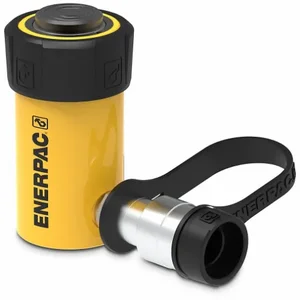Enerpac RC-102 hydraulic cylinder is used as a linear actuator that provides a unidirectional stroke and force in offshore and marine engineering applications. This 10000 psi hydraulic cylinder finds applications in the aerospace, agricultural, oil & gas, mining and food & production industries.
Features:
- Enerpac RC-102 Series hydraulic ram is used with hydraulic pumps to lift heavy equipment & workpieces in construction & automotive operations.
- It has a GR2 bearing design for reducing wear & ensuring durability.
- It is integrated with a cylinder thread protector for ease of use and a heavy-duty pre-tensioned spring for improving the retraction speed.
- It has alloy steel construction for massive strength and baked enamel finish for protection against corrosive fluids & chemicals.
- This hydraulic cylinder has a plunger wiper for protection against external contamination and base mounting holes for easy fixturing.
- Enerpac RC102 seal kit for sealing gaps between different parts of hydraulic cylinder is also available.
Compatible Accessories:
- Cylinder Saddles: Used to prevent plunger damage by uniformly distributing the load (Enerpac A12 Flat Saddle, A102G Grooved Saddle, CATS12 Tilt Saddle).
- Mounting Block: Used to mount the cylinder into the press frame and facilitate side to side adjustment (Enerpac RB10 and AW102).
- Clevis Eye: Used to easily attach components and other accessories to the cylinder units (Enerpac REB10 Base Clevis Eye and REP10 Plunger Clevis Eye).
Frequently Asked Questions:
Q. What is the difference between a double-acting and single-acting hydraulic cylinder?
A. Double-acting cylinders move (extend and retract) the load in both directions without the need for a spring. The single-acting cylinders are mainly used in light to medium-duty industrial applications requiring force in one direction. Double-acting cylinders provide more speed and force for lifting / releasing loads than the single-acting cylinders.
Q. What should I do if my Enerpac RC-102 hydraulic cylinder is not retracting properly?
A. Check for any obstructions or binding that may be preventing the free movement of the piston. Inspect the cylinder seals for leaks or damage. Verify that the hydraulic fluid level is adequate and that there are no air bubbles trapped in the system.
Q. How do I prevent corrosion and rust on a hydraulic cylinder?
A. Keep the cylinder and surrounding components clean and free from moisture, dirt and other contaminants. Consider applying a protective coating or paint to the cylinder surface, especially if it will be exposed to harsh environmental conditions.
Q. How do I prevent cavitation in a single-acting hydraulic cylinder?
A. Cavitation can occur when there is insufficient hydraulic fluid flow to meet the demand of the cylinder. To prevent cavitation, ensure that the hydraulic pump is properly sized for the application and that the hydraulic fluid is clean and free from air bubbles. Monitor system pressure and flow rate during operation to detect any signs of cavitation early.









